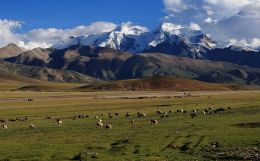Difference between revisions of "Qinghai-Tibet Plateau"
(FICsINrJnDqTrOLEPGz) |
imported>Ciic |
||
| (8 intermediate revisions by 7 users not shown) | |||
| Line 1: | Line 1: | ||
| − | + | [[file: tibet plateau.jpg|thumb|260px|Qinghai-Tibet Plateau]] | |
| + | Situated in southwest China, the '''Qinghai-Tibet Plateau''' ('''青藏高原''') is the largest plateau in China, covering 2.5 million square km, or nearly a quarter of the national total land area. It is also the highest plateau on earth, and is known as the "roof of the world." | ||
| + | |||
| + | As it is surrounded and traversed by several snow-capped mountain ranges, like the Kunlunshan, Qilianshan, Hengduanshan and the Himalayas, which abound in glacier, the Qinghai-Tibet Plateau is where many of China's major rivers originate. | ||
| + | |||
| + | The high-speed rail network will extend into the plateau as a route linking Xinjiang with inland is scheduled to start running through Qinghai Province in December 2014. | ||
| + | |||
| + | The train will run at a speed from 200 km/h to 250 km/h on the plateau, reducing the travel time between Qinghai capital Xining and Gansu capital Lanzhou to one hour. | ||
| + | |||
| + | |||
| + | |||
| + | |||
| + | [[Category:plateaus of China]] | ||
Latest revision as of 01:35, 17 November 2014
Situated in southwest China, the Qinghai-Tibet Plateau (青藏高原) is the largest plateau in China, covering 2.5 million square km, or nearly a quarter of the national total land area. It is also the highest plateau on earth, and is known as the "roof of the world."
As it is surrounded and traversed by several snow-capped mountain ranges, like the Kunlunshan, Qilianshan, Hengduanshan and the Himalayas, which abound in glacier, the Qinghai-Tibet Plateau is where many of China's major rivers originate.
The high-speed rail network will extend into the plateau as a route linking Xinjiang with inland is scheduled to start running through Qinghai Province in December 2014.
The train will run at a speed from 200 km/h to 250 km/h on the plateau, reducing the travel time between Qinghai capital Xining and Gansu capital Lanzhou to one hour.
